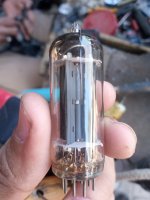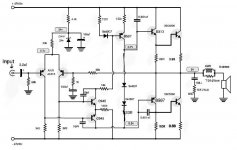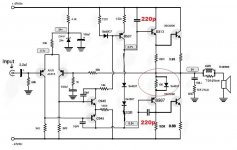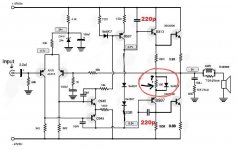Extremely Sorry Bcoz I Can't Reply To Everyone definately It Will Takes a Lot Of Time And Also sorry For My Bad EnglishHere is where you will learn the basics about amplifiers:
Robert Cordell Engineering Audio Power Amplifiers
Douglas Self Audio Power Amplifier Design Handbook
or for the math heavy theory, Marshal Leach Introduction to Electroacoustics and Audio Amplifier Design
You can look for posts and WEB sites from folks like Nelson Pass, John Curl, and Jan Didden. Oh, don't forget Ron Elliot, Elliot Sound Products.
Then download whatever version of SPICE is available to you. I expect it is available to you. I use LTSpice.
Yes, your second "version" is a bit better. But, do you understand why each change may be better?
There are many ways to get something done. The actually smart folks I mention all have slightly different approaches. Even me, with my very limited experience, have my preferences. For example, I tend to like MOSFET outputs.
When you get in deep and understand the differences, it gets quite fun. You don't get much just copying a design.
Here is one I was playing with when I was first learning. Not finished and I have even more "hindsight" and would change it quite bit if I were to build one. (no claims if it would actually work, so do not build it!) But it is a fairly strait forward design covering the basics. You can also find schematics for well respected amps, everything from the Aragon, Music Fidelity, Creek, Quad, Parasound, and many more. All different for different reasons. Informative to see the differences.
I Am From Pakistan.. In The Old Days Here Amplifier Were Uses In Every Home that Were Beautifully Designs And Well Light Decorated That Was Golden Days But Now A Days Every One Wants Ready Made or Portable Speakers Etc No One Want To build by Own Self this Is My Hobby and I Want to get deep inside Amplifiers.
No spec, but even the worst MJE340 has an fT of around 20 MHz. Typical ST parts are around 50. Their only real “problem” is beta linearity. Keep it confined to the 5 to 20 mA range like a VAS normally would and they’re fine. But they fall off at very low and high current like most early types do.
You should be able to get MJE340’s, even in Pakistan. Might even still be able to get discarded CRT TVs to salvage the video outputs.
You should be able to get MJE340’s, even in Pakistan. Might even still be able to get discarded CRT TVs to salvage the video outputs.
Thank You So much all Of You From Heart And Soul I Have Downloaded The PDF Of Robert cordel or douglas Self Power Amp Design Such A Amazing And Huge explanation about Amplifiesrs I Will Print these PDF As Books..Here is where you will learn the basics about amplifiers:
Robert Cordell Engineering Audio Power Amplifiers
Douglas Self Audio Power Amplifier Design Handbook
or for the math heavy theory, Marshal Leach Introduction to Electroacoustics and Audio Amplifier Design
You can look for posts and WEB sites from folks like Nelson Pass, John Curl, and Jan Didden. Oh, don't forget Ron Elliot, Elliot Sound Products.
Then download whatever version of SPICE is available to you. I expect it is available to you. I use LTSpice.
Yes, your second "version" is a bit better. But, do you understand why each change may be better?
There are many ways to get something done. The actually smart folks I mention all have slightly different approaches. Even me, with my very limited experience, have my preferences. For example, I tend to like MOSFET outputs.
When you get in deep and understand the differences, it gets quite fun. You don't get much just copying a design.
Here is one I was playing with when I was first learning. Not finished and I have even more "hindsight" and would change it quite bit if I were to build one. (no claims if it would actually work, so do not build it!) But it is a fairly strait forward design covering the basics. You can also find schematics for well respected amps, everything from the Aragon, Music Fidelity, Creek, Quad, Parasound, and many more. All different for different reasons. Informative to see the differences.
I will Teach Every things About Amplifiers from These Golden Books
Then I will Came Here again And Post My Own Amplifier Design.. Thanks All
Here D1047 B817 2sC5200 2sA1943 Tip 41 Tip42 Are Commonly Available But Some Transistors Are Rarely Available Like Audio Tubes or 2n3440 Or 2n3773 etc...No spec, but even the worst MJE340 has an fT of around 20 MHz. Typical ST parts are around 50. Their only real “problem” is beta linearity. Keep it confined to the 5 to 20 mA range like a VAS normally would and they’re fine. But they fall off at very low and high current like most early types do.
You should be able to get MJE340’s, even in Pakistan. Might even still be able to get discarded CRT TVs to salvage the video outputs.
Attachments
Last edited:
Another workaround is to use a TRIPLE output stage. If you are stuck using TIP41/2 drivers because literally nothing else is available, it becomes much less unacceptable if you use something like MPSA42/92 pre-drivers. This will at least minimize the damage that the TIPs will do by reducing the nonlinear capacitive loading on the VAS by the output stage. Having the extra gain will help things. A lot. It brings up the “effective” fT. Stability will be trickier, but not impossible (I have done it, even with 60 dB of NFB). If you do use a triple, you could also use D1047/B817 as drivers instead of the TIPs. For very large amplifiers with many paralleled outputs this is actually appropriate. For a triple output stage, using a proper bias regulator using a Vbe multiplier instead of just a stack of 1N4004’s becomes a must have.
The amp I built had 2N5551/5401 predrivers, TIP31/32C drivers, and TIP35/36C outputs. All generic transistors. It was even a class H output stage (which you can skip). Sounded good and was stable. Best in the world? No. But plenty acceptable.
The amp I built had 2N5551/5401 predrivers, TIP31/32C drivers, and TIP35/36C outputs. All generic transistors. It was even a class H output stage (which you can skip). Sounded good and was stable. Best in the world? No. But plenty acceptable.
Getting real transistors instead of fakes is a problem in most countries. Farnell and RS distributors might operate in Pakistan due to the historic tie to UK. They are authorized distributors of On, SK, semiconductor. Let distributors handle getting their box across the border instead of ordering from outside. Toshiba & Sanyo transistors we get here is mostly ****ese clones that might meet the real datasheet specs and might not.I Am From Pakistan.. this Is My Hobby and I Want to get deep inside Amplifiers.
Many repairman in small countries test every lot of transistors for Iceo at significant Vce (1/2 of Vceo spec) to see if they are real or trash substituted by the guards at the border. Use a 10k or 47k resistor series the power supply & the milliamp scale of DVM to avoid damaging the transistor. I=V/resistor value the transistor is trash.
Per WGski comment post 25, I would trutst an On semi parts from farnell or digikey here in the US to meet low Cob. I have found NTE radio shack NJ semi Central semi and other trash houses sometimes only meet Vceo & Vsat. Vsat is not useful for audio. The datasheets frequently don't even show the more difficult to test for parameters.
Make contact with a scrapyard or junk shop. I find used PA amplifiers on ebay or craigslist here to be economic sources of genuine, if often blown up parts. Usually the output transistors and rail caps are bad, the cases, fans, heatsinks, transformers, input parts, some controls are usually okay. Junk is much more freebooter in small countries. Many junk men take valuable relics directly to the copper yard to be burned to get the copper out.
Last edited:
Change to this:https://leachlegacy.ece.gatech.edu/lowtim/
a friend of mine use superamp. for his B&W801 & Rogers 3/5A for nearlly 20years.
a friend of mine use superamp. for his B&W801 & Rogers 3/5A for nearlly 20years.
Thanks For Interest Here You are 100℅ Right As Every Thing You Written Is Truth Here Fake Transistors Commonly Used Like TTC5200 Etc But I Always try To buy Original From Here The Original Prize Is Double From Fake...but I Always Try to Use Original Parts For AmplifiersGetting real transistors instead of fakes is a problem in most countries. Farnell and RS distributors might operate in Pakistan due to the historic tie to UK. They are authorized distributors of On, SK, semiconductor. Let distributors handle getting their box across the border instead of ordering from outside. Toshiba & Sanyo transistors we get here is mostly ****ese clones that might meet the real datasheet specs and might not.
Many repairman in small countries test every lot of transistors for Iceo at significant Vce (1/2 of Vceo spec) to see if they are real or trash substituted by the guards at the border. Use a 10k or 47k resistor series the power supply & the milliamp scale of DVM to avoid damaging the transistor. I=V/resistor value the transistor is trash.
Per WGski comment post 25, I would trutst an On semi parts from farnell or digikey here in the US to meet low Cob. I have found NTE radio shack NJ semi Central semi and other trash houses sometimes only meet Vceo & Vsat. Vsat is not useful for audio. The datasheets frequently don't even show the more difficult to test for parameters.
Make contact with a scrapyard or junk shop. I find used PA amplifiers on ebay or craigslist here to be economic sources of genuine, if often blown up parts. Usually the output transistors and rail caps are bad, the cases, fans, heatsinks, transformers, input parts, some controls are usually okay. Junk is much more freebooter in small countries. Many junk men take valuable relics directly to the copper yard to be burned to get the copper out.
I Have Create A Design of Another Shematic After Learning Some Basics Of Amplifiers in A Short Time... The Parts I Used In The Schematic Are Commonly Available Here So I Put Them In Shematic Can any One Simulate This Shematic for Me In Spice Coz How Much Out Put Power I Can Get From It???
I Am using 35v 35v AC Transformer For It...
Thanks In Advance......
I Am using 35v 35v AC Transformer For It...
Thanks In Advance......
Attachments
Quasi Complementary Output Section ( all NPN power transistors)
Needs extra resistor and baxandall diode
.001uf capacitors or 1n on driver transistors D313/B507
is incredible high, this would make high frequency performance very poor.
Those help stabilize the amplifier but shouldn't have to be higher than
100 to 220p
Only pair of output transistors, good for 90 / 100watts max
use only 35 to 38 volt supply rails.
Needs extra resistor and baxandall diode
.001uf capacitors or 1n on driver transistors D313/B507
is incredible high, this would make high frequency performance very poor.
Those help stabilize the amplifier but shouldn't have to be higher than
100 to 220p
Only pair of output transistors, good for 90 / 100watts max
use only 35 to 38 volt supply rails.
Last edited:
Thanks White Dragon I Understand What You Are Try To Say The Main Problem Is That Here Just Few Transistor Are Available Many Of Them Are Chinese Version not Original...
Anyways Can U Edit My Schematic For Good Performance I Know You Can do Easily...
Can You put Extra Resistors And Baxandal Diodes in My Schematic Kindly...
I Am Using 12inches Speakers With It..
Once Again Thanks,,,
Anyways Can U Edit My Schematic For Good Performance I Know You Can do Easily...
Can You put Extra Resistors And Baxandal Diodes in My Schematic Kindly...
I Am Using 12inches Speakers With It..
Once Again Thanks,,,
I suggest maybe only 35 to 38 volt power rails
since 47 volts would allow more than 100 watts at 4 ohms
If you do use 47 volts then the amplifier should only use
8 ohm loads minimum
since 47 volts would allow more than 100 watts at 4 ohms
If you do use 47 volts then the amplifier should only use
8 ohm loads minimum
Attachments
Last edited:
Thank You So Much White Dragon I Will Built This Amplifier And Will Post Here Again After Building Amplifier From This Schematic... Wow Amazing Work Thanks Brother...I suggest maybe only 35 to 38 volt power rails
since 47 volts would allow more than 100 watts at 4 ohms
Hopefully you understand that Bipolar Transistors
When they heat up require less bias voltage.
So the bias network is usually designed
to Thermally Track output transistors.
When they heat up, the circuit lowers bias.
In your case using Diodes for Bias
The Diodes are usually mounted near the heatsink
So they thermal track
also you may want to add potentiometer and set resistor
so you can adjust bias.
When they heat up require less bias voltage.
So the bias network is usually designed
to Thermally Track output transistors.
When they heat up, the circuit lowers bias.
In your case using Diodes for Bias
The Diodes are usually mounted near the heatsink
So they thermal track
also you may want to add potentiometer and set resistor
so you can adjust bias.
Can I Fix Bias Without Potmeters???Hopefully you understand that Bipolar Transistors
When they heat up require less bias voltage.
So the bias network is usually designed
to Thermally Track output transistors.
When they heat up, the circuit lowers bias.
In your case using Diodes for Bias
The Diodes are usually mounted near the heatsink
So they thermal track
also you may want to add potentiometer and set resistor
so you can adjust bias.
Anyways I Will Built It And Then If I Get Any Issue I Will Talk To You Again... Thanks Man....
Should I Add Another 100r Resistor With Diode As U Mark In The Shematics Or Just Put Diode To Existing 100r?????????I suggest maybe only 35 to 38 volt power rails
since 47 volts would allow more than 100 watts at 4 ohms
If you do use 47 volts then the amplifier should only use
8 ohm loads minimum
Attachments
Don’t build any large-ish amplifier without a way to adjust the output stage bias. If you don’t you're asking for trouble. There is no way to get it “spot on”, especially if you go substituting transistors. The only way to be safe with NO adjustment is to deliberately under-bias it, but that gives gross distortion with most circuits. There are circuits you CAN under-bias and get away with it, but they still require bias adjustment. A vbe multiplier is not hard to add to ANY amplifier, almost foolproof, and doesn’t need any special transistor. Yes, you can even use a TIP41 (But will need an insulator on the heat sink, which is why everyone uses encapsulated types instead). A series resistor (pot) will work too - but you need to be able to work out the required range for the pot. You need to be able to adjust the voltage on the emitter resistors, and that requires a meter. IMO, you cant build any amplifier without one so don’t try. Doesn’t need to be expensive, just needs to be able to read DC millivolts, preferably down to 0.1 millivolts.
With +/-47 volt power supply you need two pairs of output transistors per channel. Period. 2SC5200’s will be fine, as long as they are not FAKE. The ”N” version is fine, so is the TTC.
If you want to build something that requires NO bias adjustment and uses only one output pair, build Elvee’s “Circlophone”. It does require some schottky diodes (do not just substitute 1N4001s), and at least a halfway decent pair of driver transistors (No TIPs). Can’t run all the way up at +/-47 volts though - +/-35 or 38 is about the limit because of the one pair of outputs. It cannot easily be adapted for two pair just by paralleling like most amps can. But it is just plug and play. It COULD be run safely on +/-47 volts, but only with 250 watt metal outputs MJ15024, MJ21194, or one of the old big bruisers like 2N6259’s. You probably wont find a real one in your country if you’re having trouble getting real driver transistors.
With +/-47 volt power supply you need two pairs of output transistors per channel. Period. 2SC5200’s will be fine, as long as they are not FAKE. The ”N” version is fine, so is the TTC.
If you want to build something that requires NO bias adjustment and uses only one output pair, build Elvee’s “Circlophone”. It does require some schottky diodes (do not just substitute 1N4001s), and at least a halfway decent pair of driver transistors (No TIPs). Can’t run all the way up at +/-47 volts though - +/-35 or 38 is about the limit because of the one pair of outputs. It cannot easily be adapted for two pair just by paralleling like most amps can. But it is just plug and play. It COULD be run safely on +/-47 volts, but only with 250 watt metal outputs MJ15024, MJ21194, or one of the old big bruisers like 2N6259’s. You probably wont find a real one in your country if you’re having trouble getting real driver transistors.
IAm Too Much confused Or Can U Edit Shematics With Vbe Multiplyer for bjt.??Should I Add Another 100r Resistor With Diode As U Mark In The Shematics Or Just Put Diode To Existing 100r?????????
Your adding the resistor 100r and diode, yes
Agree with wg_ski
needs adjustable bias
Agree with wg_ski
needs adjustable bias
I will make schematic for youIAm Too Much confused Or Can U Edit Shematics With Vbe Multiplyer for bjt.??
- Home
- Amplifiers
- Solid State
- Building Class AB Amplifier Do I Need Some Changes??



